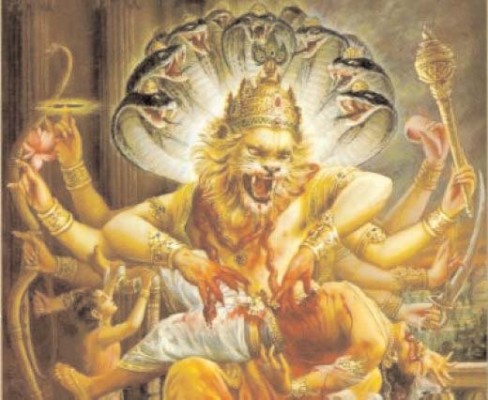Ugram Veeram Maha Vishnum Jwalantam Sarvathomukham | Narasimham Bheshanam Badram Mruthyor Mruthyum Namamyaham ||
Bow to thee, Lord Narasimha, ferocious, chivalrous, Maha Vishnu, radiant faced, omnipresent, bestower of auspiciousness and remover of birth and death cycles
Ahobilam is located in Karnool district of Andhra Pradesh in the hills of the eastern ghats, about 400 KM northwest of Chennai. It is one such holy place, where the Supreme Personality of Godhead, Krishna appeared as Lord Narasimha, the half man-half lion descent. The Ahobilam temples are maintained by the Ahobilam mutt, an important Sri Vaishnava religious institution established about 600 years ago. It is the place where the Lord killed Hiranyakasipu and saved Prahalada. Mahalakshmi took avatar as Senjulakshmi among the Senju, tribal hunters of the hills, and married the Lord. Aho is an exclamation word. Bhilam (bhilam means cave). It is equivalent of ‘oh the mighty cave’ and thus aho-bhilam of lord Narasimha swamy.
It is stated that the Devas (Gods), while witnessing the terrific aspect (Ugra Kala), the lord took on in order to tear to pieces Hiranyakasipu sung in His praise as ‘Ahobala’ (the strength). Hence this place has come to be known as Ahobilam or Ahobalam. It is also said that Garuda wished for a vision of Lord Nrisimha in the form of the Avatara. To fulfill his wish, the Lord settled in the hills around Ahobilam in the midst of dense forests in nine different forms. For this reason this hill came to be known as Garudadri, Garudachalam, and Garudasailam. The temple consists of nine shrines to Lord Nrisimha located around a 5 KM circle. In addition to the nine shrines, there is a temple for Prahaladavarada Varadhan in the foothills of the mountain. Due to security reasons and the difficulty in performing daily worship, many of the utsava vigrahas of the nine shrines are kept in this temple.
Lakshmi Narasimha Swamy Temple :
This Temple is situatd in lower Ahobilam. It is also called Prahalada Varadan and Santa Narasimha . The temple is built in south Indian style with grand architectural design and the sculptures in the pillars and walls.
The Nine Temples
Although the Deity of Lord Narasimha is fierce-looking with His tooth and jaws open in a mood to kill the demon, a devotee knows the merciful & protective nature of the Lord and he approaches Him in a mood of humility. Ahobilam consists of nine forms of Lord Narasimha located around a 5 km circle.
1) Kroda (Varaha) Narasimha
This is a temple cave in upper Ahobilam. In this temple the Lord takes the form of a boar and so He is called as Kroda or Varaha Narasimha Swami. Varaha, the boar incarnation of Lord Krishna, killed Hiranyakasipu’s younger brother, Hiranyaksha, thus incurring the wrath and hatred of Hiranyakasipu. The two forms of the Lord, Narasimha and Varaha, responsible for destroying the two demon-brothers, have been installed together in this temple.
This shrine is situated at the foot of the Vedadri mountain with the river Bhavanasini flowing besides it. This river water flows from the Jwala Narasimha just beside the Ugra Sthambam and is believed to have medicinal properties as it flows over many herbs amidst the forest. It is said that to lessen or calm down the anger of Ugra Narasimha, Akashaganga (Goddess Ganga) descended and flowed like ‘Antarvahini’ of Bhavanashini River. Most of the devotees have a dip in the water as it is considered sacred.
2) Bhargava-Narasimha:
Bhargava is another name of Parasurama, the warrior incarnation of the Lord who had performed penance near Ahobila.
3) Chatravada-Narasimha:
The Deity is installed under a peepal tree surrounded by thorny bushes.
4) Yogananda-Narasimha (Lord in Meditation)
5) Karanja-Narasimha:
Named after a fruit bearing tree, growing next to the temple.
6) Ugra-Narasimha:
Ferocious form of the Lord inside a cave between two mountains. The Lord here appears in his fierce aspect, called Ugra Narasimha, who is the presiding deity of the temple and is known as Ahobila Nrisimha Swamy. It is firmly believed the Lord Narasimha was ‘Svayambhu’ (self-manifest) here.
7) Jvala-Narasimha:
The exact place where the Lord killed the demon King Hiranyakasipu. Next to this temple is a large stream – and at the spot where the Lord washed His hands after killing the demon the water flows blood-red even now and so it is called Raktakund/ bloody lake.
8) Malola-Narasimha (Beloved of Goddess Lakshmi)
9) Paavan-Narasimha (The Lord on the bank of river Paavan or Bhavanashini)
The Historic Pillar (Ugra Stamba):
This large stone pillar is said to be the actual pillar from which Lord Narasimha appeared. The demoniac king Hiranyakasipu was very much disturbed seeing his son Prahlad always Krishna conscious. Failing in his numerous attempts to stop his son from his Krishna conscious activities and even to kill him, the atheistic king once angrily challenged his son whether His God existed within the pillars of his palace. Prahlada confidently replied that since the Lord is everywhere, He’s also present in the pillars.
When Hiranyakasipu heard this philosophy from his young son, he derided him and out of great anger forcefully struck the pillarwith his fist. Immediately, with great tumultuous sound, the Lord appeared in His wonderful avatar as Narasimha, half lion and half man. So, this pillar is very significant. The pillar is named Ugra Stambha indicating the Lord’s mood of anger towards the enemy of His devotee.It consists of imprints of Narasimhar’s patham (foot) on a stone.
Prahlad’s school:
This is the place where 5-year old Prahlad educated his friends about the messages of Krishna Consciousness (Prahlad’s instructions). Although Prahlad was born in a demoniac family, he was a devotee of Lord Krishna. He was most compassionate and didn’t waste a moment. He taught all his friends the importance of God-realization. This place has Sanskrit writings on the walls dating from the days of Prahlad’s studies here. There is a small cave, where a deity of Prahlad is installed.
